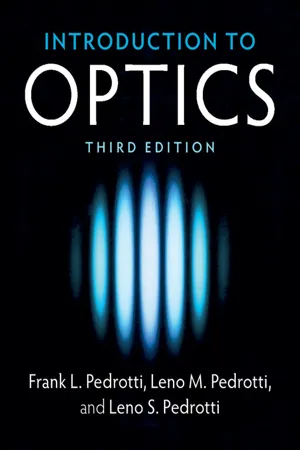
- English
- PDF
- Available on iOS & Android
Introduction to Optics
About this book
Introduction to Optics is now available in a re-issued edition from Cambridge University Press. Designed to offer a comprehensive and engaging introduction to intermediate and upper level undergraduate physics and engineering students, this text also allows instructors to select specialized content to suit individual curricular needs and goals. Specific features of the text, in terms of coverage beyond traditional areas, include extensive use of matrices in dealing with ray tracing, polarization, and multiple thin-film interference; three chapters devoted to lasers; a separate chapter on the optics of the eye; and individual chapters on holography, coherence, fiber optics, interferometry, Fourier optics, nonlinear optics, and Fresnel equations.
Frequently asked questions
- Essential is ideal for learners and professionals who enjoy exploring a wide range of subjects. Access the Essential Library with 800,000+ trusted titles and best-sellers across business, personal growth, and the humanities. Includes unlimited reading time and Standard Read Aloud voice.
- Complete: Perfect for advanced learners and researchers needing full, unrestricted access. Unlock 1.4M+ books across hundreds of subjects, including academic and specialized titles. The Complete Plan also includes advanced features like Premium Read Aloud and Research Assistant.
Please note we cannot support devices running on iOS 13 and Android 7 or earlier. Learn more about using the app.
Information

Table of contents
- Cover
- Half-title
- Dedication
- Title page
- Copyright information
- Brief Contents
- Table of contents
- Physical Constants
- Preface
- Part I
- Part II
- References
- Answers to Selected Problems
- Index